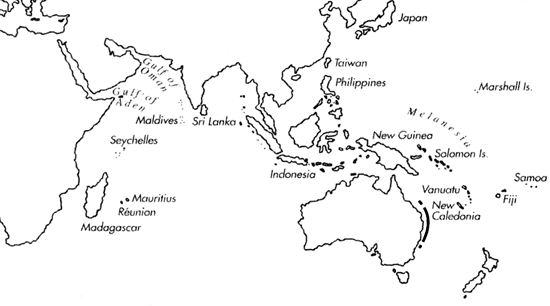Range: New South Wales to Queensland, Australia.
Description: Moderately small, moderately light to moderately solid. Last whorl conical to broadly conical, outline straight to slightly convex; left side concave above base. Shoulder angulate to slightly carinate. Spire of low to moderate height, slightly stepped in later whorls; outline straight to domed. Larval shell of 1.5-1.75 whorls, maximum diameter about 1.1 mm. Teleoconch sutural ramps flat, concave in late whorls, with 1 increasing to 5-6 spiral grooves. Last whorl with closely spaced spiral ribs.
| Shell Morphometry | ||
|---|---|---|
| L | 25-36 mm | |
| RW | 0.06-0.14 g/mm | |
| RD | 0.64-0.72 | |
| PMD | 0.86-0.93 | |
| RSH | 0.07-0.16 | |
Ground colour white. Last whorl with 3 variably solid spiral bands of brown axial streaks and flecks, below shoulder, at centre and within abapical third; intervening white bands may have sparse spiral rows of widely set brown dots. Larval shell white. Postnuclear sutural ramps with rather sparse brown radial streaks and blotches extending beyond outer margins, partially reduced to marginal spots. Aperture white to pale brown.
Habitat and Habits: In 50 to 100 m. C. minnamurra seems to be restricted to the warm temperate and subtropical waters of the E. Australian overlap region.
Discussion: C. minnamurra may be confused with C. limpusi (Walls, [1979]; Richard, 1990) and is also similar to C. lizardensis; for comparison, see the Discussions of those species.

C. minnamurra range map
This section contains verbatim reproductions of the accounts of 316 species of Conus from the Indo-Pacific region, from Manual of the Living Conidae, by Röckel, Korn and Kohn (1995). They are reproduced with the kind permission of the present publisher, Conchbooks.
All plates and figures referred to in the text are also in Röckel, Korn & Kohn, 1995. Manual of the Living Conidae Vol. 1: Indo-Pacific Region.
The range maps have been modified so that each species account has it own map, rather than one map that showed the ranges of several species in the original work. This was necessary because each species account is on a separate page on the website and not confined to the order of accounts in the book.